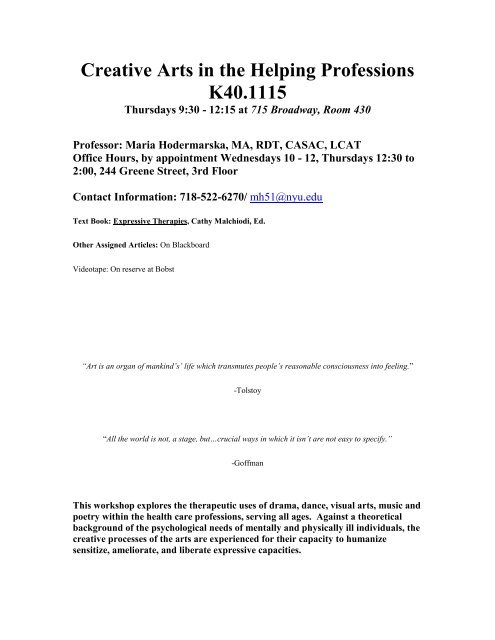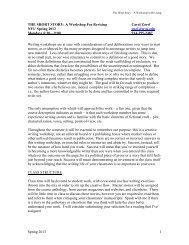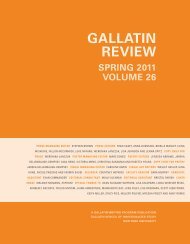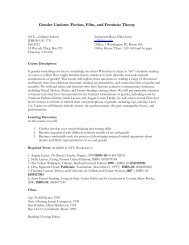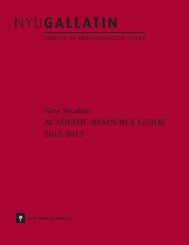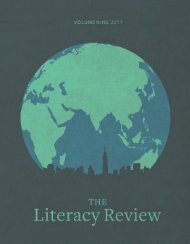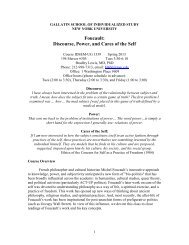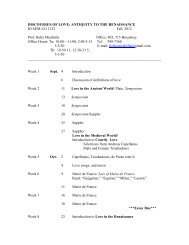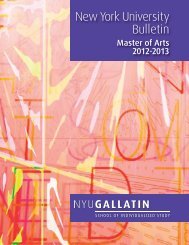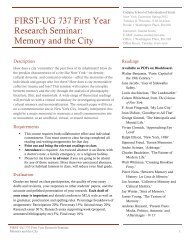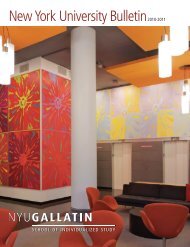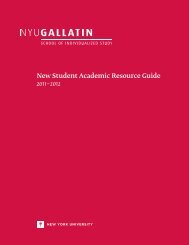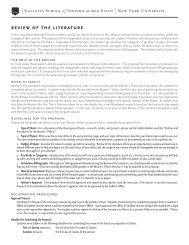ARTS-UG1115 - Gallatin School of Individualized Study - New York ...
ARTS-UG1115 - Gallatin School of Individualized Study - New York ...
ARTS-UG1115 - Gallatin School of Individualized Study - New York ...
You also want an ePaper? Increase the reach of your titles
YUMPU automatically turns print PDFs into web optimized ePapers that Google loves.
Creative Arts in the Helping Pr<strong>of</strong>essions<br />
K40.1115<br />
Thursdays 9:30 - 12:15 at 715 Broadway, Room 430<br />
Pr<strong>of</strong>essor: Maria Hodermarska, MA, RDT, CASAC, LCAT<br />
Office Hours, by appointment Wednesdays 10 - 12, Thursdays 12:30 to<br />
2:00, 244 Greene Street, 3rd Floor<br />
Contact Information: 718-522-6270/ mh51@nyu.edu<br />
Text Book: Expressive Therapies, Cathy Malchiodi, Ed.<br />
Other Assigned Articles: On Blackboard<br />
Videotape: On reserve at Bobst<br />
“Art is an organ <strong>of</strong> mankind’s’ life which transmutes people’s reasonable consciousness into feeling.”<br />
-Tolstoy<br />
“All the world is not, a stage, but…crucial ways in which it isn’t are not easy to specify.”<br />
-G<strong>of</strong>fman<br />
This workshop explores the therapeutic uses <strong>of</strong> drama, dance, visual arts, music and<br />
poetry within the health care pr<strong>of</strong>essions, serving all ages. Against a theoretical<br />
background <strong>of</strong> the psychological needs <strong>of</strong> mentally and physically ill individuals, the<br />
creative processes <strong>of</strong> the arts are experienced for their capacity to humanize<br />
sensitize, ameliorate, and liberate expressive capacities.
Please note: This course <strong>of</strong>fers an overview <strong>of</strong> the creative arts<br />
therapies and their important contribution to the helping<br />
pr<strong>of</strong>essions. This course does not and will not <strong>of</strong>fer therapy to its<br />
participants. However, the course will involve first hand<br />
experience <strong>of</strong> different creative and potentially therapeutic<br />
modalities. The class will remain safe and certain in its academic<br />
goals. While some sharing <strong>of</strong> personal material may occur as a<br />
natural part <strong>of</strong> the course, students will neither be required to nor<br />
graded upon their ability for insight into their own experience.<br />
Grading will be based upon attendance, participation, and the<br />
grades received for the four Written Responses and the Final<br />
Paper. Students will not be graded on their creative work but<br />
no one can pass the class without completing each creative<br />
assignment.<br />
Students will be introduced to dance, music, art, and drama therapies, through, lecture/<br />
discussion, and first hand experience. Students will be required to dance, sing, make art,<br />
make drama, and write poetry even though the students may not necessarily be poets,<br />
dancers, musicians, etc. We will learn through our experiences <strong>of</strong> the creative arts<br />
therapy forms. Students will explore and work with a variety <strong>of</strong> materials and media and<br />
present their creative work to the class.<br />
During the course <strong>of</strong> the semester we will address the following questions: What makes<br />
something therapeutic? What makes something art? Does an experience need to be<br />
cathartic or merely soothing to <strong>of</strong>fer therapeutic value? What is the difference between<br />
art and therapy? What is the impact <strong>of</strong> the creative process on the therapeutic process?<br />
Where do these processes overlap and differ? Who can benefit from creative therapeutic<br />
interventions? How and where do creative arts therapists get their training and licensing?
Syllabus:<br />
January 27, 2011 Class cancelled due to weather<br />
February 3, Introductions, Review <strong>of</strong> Syllabus, Presentation <strong>of</strong> Key<br />
Concepts <strong>of</strong> course, Activity and Discussion<br />
February 10, Dance Therapy<br />
There is vitality, a life force, energy, a quickening that is translated through you into action and because there is only<br />
one <strong>of</strong> you in all time, this expression is unique. And, if you block it, it will never exist through any other medium and<br />
will be lost.<br />
Martha Graham<br />
Prepare:<br />
1. Read Joan Wittig Authentic Movement article (Blackboard)<br />
2. Read Chapter 4 <strong>of</strong> Expressive Therapies: Dance and Movement<br />
Therapy<br />
3. Read Chapter 1, Expressive Therapies, History, Therapy and<br />
Practice<br />
4. Read On Being and Becoming a Therapist (Blackboard)<br />
Class:<br />
Group Activity: Introduction to Authentic Movement presented by Joan<br />
Wittig, MA, ADTR, LCAT, Director <strong>of</strong> Graduate Program in Dance and<br />
Movement Therapy, Pratt Institute.<br />
Discussion<br />
February 17, Dance Therapy<br />
It is not clear to the baby how he gets from one moment to the next or what if anything, happens between them. (Is it<br />
so clear for us?) But all his senses are focused one each one, and he lives each intensely. Many are prototypes <strong>of</strong><br />
moments that will recur over and over throughout his life." Daniel Stern, MD<br />
Prepare:<br />
1. Read Piaget Article
Class:<br />
Dance Therapy. Review Laban's Effort Shape in Movement Analysis and<br />
the Kestenberg Developmental Movement Pr<strong>of</strong>ile through experiential<br />
activity. Watch Dance and Human History. Discussion<br />
February 24, Music Therapy<br />
"It don't mean a thing, if it ain't got that swing."<br />
Prepare:<br />
Duke Ellington<br />
1. Written Response #1 on Dance and Movement Therapy due in class<br />
2. Read Chapter 3, Music Therapy in Expressive Therapies<br />
3. Read Diane Austin Vocal Psychotherapy Article (Blackboard)<br />
4. Watch The Language You Cry In on reserve in Bobst Avery Fisher<br />
Center<br />
Class:<br />
Presentation by Music Therapist Brian Harris on psychodynamic<br />
approach to music therapy<br />
Activity<br />
Discussion <strong>of</strong> Reading<br />
March 3: Music Therapy<br />
“If music be the food <strong>of</strong> love, play on…”<br />
Prepare:<br />
1. Write a song <strong>of</strong> yourself to sing in class. Use an existing melody or<br />
create a new one.<br />
Class:<br />
Lecture by Jacqueline Birnbaum <strong>of</strong> the Nord<strong>of</strong>f-Robbins Institute for<br />
Music Therapy<br />
Presentation <strong>of</strong> songs.<br />
Discussion <strong>of</strong> Reading
March 10: Art Therapy<br />
I am always between two currents <strong>of</strong> thought: first the material difficulties, turning round and round and round to make a<br />
living; and second, the study <strong>of</strong> color. I am always hoping to make a discovery here, to express the feelings <strong>of</strong> two lovers by a<br />
marriage <strong>of</strong> two complementary colors, their mingling and their opposition, the mysterious vibrations <strong>of</strong> kindred tones. To<br />
express the thought behind a brow by the radiance <strong>of</strong> a bright tone against a somber background. To express hope by some<br />
star, the eagerness <strong>of</strong> a soul by a sunset glow.<br />
Vincent Van Gogh<br />
Prepare:<br />
1. Written Response #2 on Music Therapy due in class<br />
2. Read Chapter 2, Art Therapy, in Expressive Therapies<br />
3. Read Cathy Ward Shaping Connections (Blackboard)<br />
Class:<br />
Lecture Art Therapist; Activity and Discussion<br />
March 17, Mid Winter Break<br />
March 24: Art Therapy<br />
Prepare:<br />
1. Make a work <strong>of</strong> art in 3 or 2 dimensions, which you will present in class.<br />
Class:<br />
Presentation <strong>of</strong> work, Classroom art activity and discussion<br />
March 31: Drama Therapy<br />
Shakespeare had a dream - and we are it. C.G. Jung<br />
Prepare:<br />
1. Written Response #3 on Art Therapy due in class<br />
2. Read: Chapter 5, Drama Therapy and Psychodrama, in Expressive<br />
Therapy<br />
Class:<br />
Guest Lecture Marissa Manzanares<br />
Activities and Discussion
April 7, Drama Therapy<br />
We are out on a limb between the angel and the machine.<br />
Prepare:<br />
Roman Paska<br />
View Film “3 Approaches to Drama Therapy” (on reserve in the library)<br />
Read Perfume: A meditation on the countertransferential drama with<br />
babies who smell bad. (Blackboard)<br />
Class:<br />
Discussion <strong>of</strong> Theory in Drama Therapy along with experiential<br />
activities.<br />
April 14: An Integrative Arts Approach:<br />
Prepare:<br />
1. Written Response #4 on Drama Therapy due in class<br />
2. Read Chapter 9, An Integrative Arts Approach, in Expressive<br />
Therapies<br />
3. Read Operatic Play: A drama and music therapy collaboration<br />
(Blackboard)<br />
4. Bring in an instrument, an object, a work <strong>of</strong> art, etc. for class activity<br />
Class: Lecture and Discussion and Improvisational Group Experience<br />
Final Presentations and Discussion<br />
April 21: Final Presentations and Discussion<br />
April 28: Final Presentations and Discussion<br />
May 5: Final Presentations and Discussion<br />
May 12: Last class closing activities<br />
Papers due, No exceptions
Class Requirements:<br />
1. Complete all reading for the assigned class. This<br />
includes: The text book, Expressive Therapies, Cathy Malchoidi, Ed., On the<br />
Thought and Language <strong>of</strong> Children by James Britton (Blackboard), Joan<br />
WIttig Authentic Movement (Blackboard),Songs <strong>of</strong> the Self:Vocal<br />
Psychotherapy by Diane Austin (Blackboard), Cathy Ward Shaping<br />
Connections (Blackboard) Perfume: A meditation on the<br />
Countertransferential drama with babies who smell bad.<br />
(Blackboard)Operatic Play: A drama and music therapy collaboration<br />
(Blackboard) Three Approaches to Drama Therapy--Film (on reserve at<br />
Bobst Library)<br />
Recommended Readings: Thanatos and Transformation by Arthur Robbins<br />
, Changes in Self Image as Seen in Tree Paintings by Cristine Isaksson<br />
B.S.W , Ann-Katrin Norlén B.S.W , Birgitta Englund Reg. OT., M.Sc , and<br />
Rafael Lindqvist Ph.D. (Blackboard)<br />
2. Complete all creative therapy assignments for<br />
each class: a dance, a song, a work <strong>of</strong> art, a puppet<br />
3. Four Written Responses due on the day<br />
indicated. The Written Response is a 4-page (minimum) double<br />
spaced document that synthesizes the reading (plus one outside source) with<br />
your experience <strong>of</strong> the Presenter and <strong>of</strong> the activities in those classes. You<br />
will also use these response papers to answer the question: “How is<br />
dance/music/art/drama healing?” There will be one written response due for<br />
each Creative Therapeutic discipline covered in the class.<br />
You will reference the class reading (both sources) in the Response by<br />
using quotations from the reading.<br />
You will also reference a third source which is an article from the Arts<br />
In Psychotherapy (found on-line through Bobst) that relates to or<br />
connects with your thesis<br />
All Responses will have a Bibliography attached.
5. Final Presentation Project. 15 minutes MAXIMUM.<br />
Introduction 5 minutes: You will chose one discipline <strong>of</strong> Creative Arts<br />
Therapy and one population (people with eating disorders, schizophrenia,<br />
alcohol and/or other drug dependence, mood disorders, a straight medical<br />
problem etc) for this assignment. You will look up the diagnostic criteria for<br />
your population in the DSM IV (Diagnostic and Statistical Manual <strong>of</strong> Mental<br />
Disorders) or a Physicians Medical Reference (for medical disorders).<br />
Presentation <strong>of</strong> Intervention 10 minutes: You will then present a creative<br />
therapeutic intervention OF YOUR OWN DESIGN which you have<br />
created to address the therapeutic needs <strong>of</strong> the population that you have<br />
chosen. Your classmates will be your "clients" and you will take the group<br />
though the brief intervention. As the group facilitator, you will present your<br />
intervention by saying what you intend to do and what your goals and<br />
objectives are for the intervention.<br />
6. Final Paper/Summary Projects. The final paper will be<br />
8 to 10 pages in length. It will be a combination <strong>of</strong> research and selfreflection.<br />
In this paper you will write about the special population that you have<br />
selected for your presentation and you will detail the diagnostic criteria from<br />
the DSM IV.<br />
You will use your reading sources from the class or from the library to<br />
explain or "justify" your choice <strong>of</strong> intervention.<br />
You will then write about the experience <strong>of</strong> "playing the role <strong>of</strong> creative arts<br />
therapist" which you have done throughout the semester with yourself as<br />
subject and finally with your classmates as your subjects.<br />
What have you learned from the process about yourself? What have you<br />
learned about the creative therapeutic process? How do you think that it<br />
might differ from more traditional talk therapy? How is the creative<br />
therapeutic process like traditional talk therapy? And how or why are the<br />
arts healing?<br />
Bibliography will be attached.<br />
You cannot pass the class without completing all <strong>of</strong> the above five class<br />
requirements.
Grading:<br />
Any absence must be excused and you will notify the pr<strong>of</strong>essor <strong>of</strong> the<br />
absence by phone or email prior to the absence. Any absences in excess<br />
<strong>of</strong> two will result automatically in a diminished grade.<br />
Grading will be based upon attendance, participation, and the grades<br />
received for the four Written Responses (80% total @20% per paper)<br />
and the Final Paper (20%). Students will not be graded upon their<br />
creative work but you cannot pass the class without completing each<br />
creative assignment<br />
Statement on Academic Integrity<br />
Students are expected-<strong>of</strong>ten required-to build their work on that <strong>of</strong> other people, just as pr<strong>of</strong>essional<br />
researchers and writers do. Giving credit to someone whose work has helped you is expected; in fact, not to<br />
give such credit is a crime. Plagiarism is the severest form <strong>of</strong> academic fraud. Plagiarism is theft. More<br />
specifically, plagiarism is presenting as your own:<br />
a phrase, sentence, or passage from another writer's work without using quotation marks;<br />
a paraphrased passage from another writer's work;<br />
facts, ideas, or written text gathered or downloaded from the Internet;<br />
another student's work with your name on it;<br />
a purchased paper or "research" from a term paper mill.<br />
Other forms <strong>of</strong> academic fraud include:<br />
"collaborating" between two or more students who then submit the same paper under their<br />
individual names.<br />
submitting the same paper for two or more courses without the knowledge and the expressed<br />
permission <strong>of</strong> all teachers involved.<br />
giving permission to another student to use your work for a class.<br />
Term paper mills (web sites and businesses set up to sell papers to students) <strong>of</strong>ten claim they are merely<br />
<strong>of</strong>fering "information" or "research" to students and that this service is acceptable and allowed throughout<br />
the university. THIS IS ABSOLUTELY UNTRUE. If you buy and submit "research," drafts, summaries,<br />
abstracts, or final versions <strong>of</strong> a paper, you are committing plagiarism and are subject to stringent<br />
disciplinary action. Since plagiarism is a matter <strong>of</strong> fact and not intention, it is crucial that you acknowledge<br />
every source accurately and completely. If you quote anything from a source, use quotation marks and take<br />
down the page number <strong>of</strong> the quotation to use in your footnote.<br />
Consult The Modern Language Association (MLA) Style Guide for accepted forms <strong>of</strong> documentation, and<br />
the course handbook for information on using electronic sources. When in doubt about whether your<br />
acknowledgment is proper and adequate, consult your teacher. Show the teacher your sources and a draft <strong>of</strong>
the paper in which you are using them. The obligation to demonstrate that work is your own rests with you,<br />
the student. You are responsible for providing sources, copies <strong>of</strong> your work, or verification <strong>of</strong> the date work<br />
was completed.<br />
The academic community takes plagiarism very seriously. Teachers in our writing courses must report to<br />
the Director <strong>of</strong> the Expository Writing Program any instance <strong>of</strong> academic dishonesty in student writing,<br />
whether it occurs in an exercise, draft, or final essay. Students will be asked to explain the circumstances <strong>of</strong><br />
work called into question. When plagiarism is confirmed, whether accidental or deliberate, students must<br />
be reported to the Dean <strong>of</strong> their <strong>School</strong>, and penalties will follow. This can result in failure <strong>of</strong> the essay,<br />
failure in the course, a hearing with the Dean, and/or expulsion from the university. This has happened to<br />
students at <strong>New</strong> <strong>York</strong> University.<br />
For more information on avoiding plagiarism and proper use <strong>of</strong> internet citation, we recommend visiting<br />
these websites:<br />
“What Is Plagiarism at Indiana University?” Indiana University. A tutorial that tests your ability to<br />
understand and avoid plagiarism.<br />
Virtual Salt. “Citing Web Sources MLA Style.” By Robert Harris. Guidelines to what to cite and how to<br />
cite in Modern Language Association style.<br />
“How to Avoid Plagiarism.” Northwestern University. A comprehensive site about academic integrity and<br />
citing sources.<br />
NYU Policy on plagiarism and fabrication:<br />
This class follows NYU’s zero tolerance policy with regard to<br />
plagiarism. Taking the writing <strong>of</strong> someone else, in whole or in part and<br />
presenting it as your own will result in serious academic consequences.<br />
You will use quotations in your papers and follow MLA or APA style<br />
book for references and bibliography. You will always make clear the<br />
difference between your thoughts or ideas and those belonging to<br />
someone else. Great scholarship is the ability to use the ideas <strong>of</strong> others<br />
to build your own unique argument on a topic.


